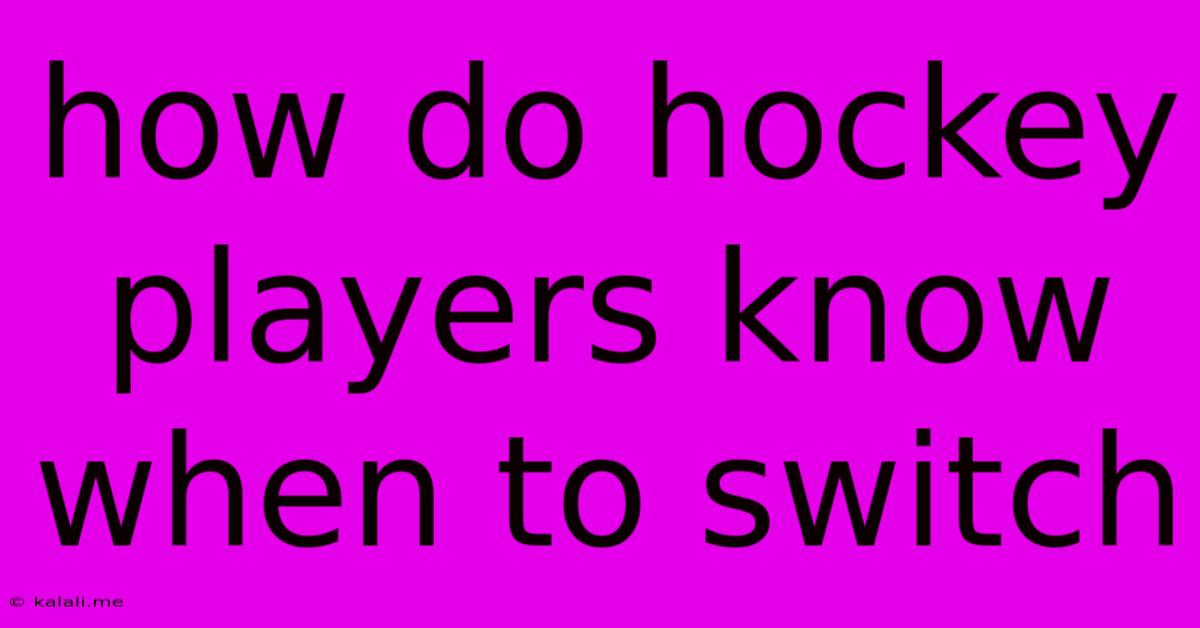How Do Hockey Players Know When To Switch
Kalali
Jun 09, 2025 · 3 min read

Table of Contents
How Do Hockey Players Know When to Switch? The Art of Line Changes in Ice Hockey
Ice hockey is a game of relentless speed and strategic maneuvering. One crucial element often overlooked by casual viewers is the seemingly seamless transition between lines – the line change. This article will delve into the complex factors determining when a hockey player switches, exploring both the on-ice cues and the pre-planned strategies that govern this vital aspect of the game. Understanding this intricate process reveals the high level of coordination and anticipation required at the elite level.
Reading the Game: On-Ice Indicators for Line Changes
The decision to change lines isn't arbitrary; it's a dynamic process driven by several key indicators:
-
Fatigue: This is arguably the most obvious factor. Players skate at high intensity for short bursts, and fatigue inevitably sets in. A player showing signs of slowing down, missed passes, or decreased defensive effectiveness signals a need for a change. Coaches and players alike are acutely aware of individual stamina levels.
-
Offensive Zone Time: If a team maintains possession in the offensive zone, a change might be delayed until a scoring chance subsides or possession is lost. This maximizes the offensive potential before sending a fresh line onto the ice.
-
Defensive Zone Pressure: Conversely, if the team is under heavy pressure in their own zone, a quick change is imperative to prevent a goal. A fresh line can provide renewed energy and defensive prowess to clear the puck and relieve the pressure.
-
Momentum Shifts: A significant change in momentum, either positive or negative, can trigger a line change. If the team is struggling, a fresh line can inject energy and change the dynamic. If they're on a roll, a quick switch can maintain that momentum and capitalize on opportunities.
-
Matchups: Coaches frequently employ strategic line changes based on matchups against specific opposing lines. A weaker defensive line might be substituted for a stronger one when facing the opponent's top scoring line. This strategic element showcases the analytical depth of modern coaching.
Beyond the Ice: Pre-Planned Strategies and Coaching
While on-ice cues are crucial, line changes are also governed by pre-planned strategies:
-
Pre-determined Shifts: Coaches often have a planned rotation schedule, aiming for balanced ice time and player rest. This structured approach ensures every player gets a fair share of playing time while mitigating fatigue.
-
Line Combinations: The specific combinations of players on each line are carefully considered based on skill sets and synergy. Certain players excel together, creating balanced offensive and defensive units.
-
Situational Line Changes: Power plays and penalty kills involve specialized units with specific skill sets, requiring immediate and precise line changes to maximize effectiveness. These shifts are often pre-planned and executed seamlessly.
-
Communication is Key: Effective communication between players and coaches is paramount. Players need to relay their physical status and the overall on-ice situation to the bench, facilitating informed decisions about when to change. This involves non-verbal cues as well as spoken communication.
The Art of the Seamless Change
The true skill lies not just in when to change, but how. The execution of a line change must be swift and precise to avoid compromising the team's defensive position or allowing the opponent a scoring opportunity. This requires meticulous coordination and timing amongst the players involved, honed through countless hours of practice.
In conclusion, determining when to switch lines in hockey is a multifaceted process involving on-ice observation, pre-planned strategies, and seamless coordination. It's a crucial element of success at any level of the game, highlighting the complex interplay of physical exertion, strategic thinking, and team dynamics that define this exhilarating sport.
Latest Posts
Latest Posts
-
How Many Cups Is 12 Oz Of Chocolate Chips
Jul 01, 2025
-
How Do You Beat Level 7 On Bloxorz
Jul 01, 2025
-
What Grade Level Do You Learn Algebra 1
Jul 01, 2025
-
How Long Ago Was The 16th Century
Jul 01, 2025
-
How Many Inches Are In 4 Yards
Jul 01, 2025
Related Post
Thank you for visiting our website which covers about How Do Hockey Players Know When To Switch . We hope the information provided has been useful to you. Feel free to contact us if you have any questions or need further assistance. See you next time and don't miss to bookmark.